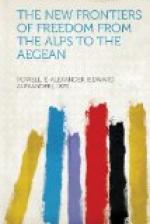found themselves with barely sufficient resources
to keep themselves from want. To add to their
discouragement, the greatest uncertainty prevailed
as to Hungary’s future. In order to obtain
an idea of just how familiar the inhabitants of the
rural districts were with political conditions, I asked
four intelligent-looking men in succession who was
the ruler of Hungary and what was its present form
of government. The first opined that the Archduke
Joseph had been chosen king; another ventured the belief
that the country was a republic with Bela Kun as president;
the third asserted that Hungary had been annexed to
Rumania; while the last man I questioned said quite
frankly that he didn’t know who was running the
country, or what its form of government was, and that
he didn’t much care. As a result of the
decision of the Peace Conference which awarded Transylvania
to Rumania and divided the Banat between Rumania and
Jugoslavia, Hungary finds herself stripped of virtually
all her forests, all her mines, all her oil wells,
and all of her manufactories save those in Budapest,
thus stripping the bankrupt and demoralized nation
of practically all of her resources save her wheat-fields.
I talked with a number of Americans and English who
were conversant with Hungary’s internal condition
and they agreed that it was doubtful if the country,
stripped of its richest territories, deprived of most
of its resources, and hemmed in by hostile and jealous
peoples, could long exist as an independent state.
On several occasions I heard the opinion expressed
that sooner or later the Hungarians, in order to save
themselves from complete ruin, would ask to be admitted
to the Jugoslav Confederation, thereby obtaining for
their products an outlet to the sea. In any event,
the Hungarians appear to have a more friendly feeling
for their Jugoslav neighbors than for the Rumanians,
whom they charge with a deliberate attempt to bring
about their economic ruin.
In spite of the prohibitive cost of labor and materials,
we found that the traces of the Austrian bombardment
of Belgrade in 1914, which did enormous damage to
the Serbian capital, were rapidly being effaced and
that the city was fast resuming its pre-war appearance.
The place was as busy as a boom town in the oil country.
The Grand Hotel, where the food was the best and cheapest
we found in the Balkans, was filled to the doors with
officers, politicians, members of parliament—for
the Skupshtina was in session—relief workers,
commercial travelers and concession seekers, and the
huge Hotel Moskowa, built, I believe, with Russian
capital, was about to reopen. Architecturally,
Belgrade shows many traces of Muscovite influence,
many of the more important buildings having the ornate
facades of pink, green and purple tiles, the colored
glass windows, and the gilded domes which are so characteristically
Russian. Though the main thoroughfare of the city,
formerly called the Terasia but now known as Milan
Street, is admirably paved with wooden blocks, the




